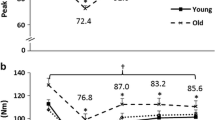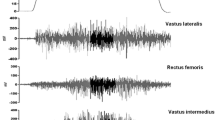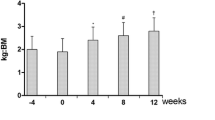Abstract
Background and aims: Age-related structural alterations in motor units and consequential functional manifestations are asserted to underlie the decline in the ability to finely grade, or control, muscular force in upper extremity musculature of older adults. Functional activities requiring appropriately graded muscular action, such as control of balance, may therefore be negatively affected by these changes. Recent investigations of smaller intrinsic hand muscles have suggested that strength training may attenuate the normal age-related decrease in strength and control of force resulting in increased strength and control. The effects of strength training on the larger, more powerful, anti-gravity muscle of the quadriceps, where age-related changes are noted earlier, are unknown. Thus, the purpose of this study was to assess the effects of 12 weeks of high intensity strength training on strength and the ability to control muscular force in untrained older adults. Methods: Twenty-two subjects aged 59–83 years (11 males, 11 females) were compared to 5 untrained, age-matched controls 58–76 years of age (3 females, 2 males). Maximal isometric knee extensor strength and control of force at 30, 60, and 90% of maximum were measured at 0, 6, and 12 weeks. Results: Significant increases in quadriceps strength were noted in the exercise group but neither group showed a change in the ability to control sub-maximal forces. Conclusions: These findings suggest that high intensity strength training may be efficacious for improving strength but does not improve the ability to control sub-maximal isometric forces.
Similar content being viewed by others
References
Schultz A., Alexander N.B., Gu M.J., Boismier T. Postural control in young and elderly adults when stance is challenged: Clinical versus laboratory measurements. Ann. Otol. Rhinol. Laryngol. 102: 508–517, 1993.
Oda K. Age changes of motor innervation and acetylcholine receptor distribution on human skeletal muscle fibers. J. Neurol. Sci. 66: 327–338, 1984.
Stalberg E., Fawcett P.R.W. Macro EMG in healthy subjects of different ages. J. Neurol. Neurosurg. Psychiatry 45: 870–878, 1982.
Tuffery A.R. Growth and degeneration of motor end-plates in normal cat hind limb muscles. J. Anat. 110: 221–247, 1971.
Brown W.F. A method for estimating the number of motor units in thenar muscles and the changes in motor unit count with ageing. J. Neurol. Neurosurg. Psychiatry 35: 845–852, 1972.
Campbell M.J., McComas A.J., Petito F. Physiological changes in ageing muscles. J. Neurol. Neurosurg. Psychiatry 36: 174–182, 1973.
Larsson L., Sjödin B., Karlsson J. Histochemical and biochemical changes in human skeletal muscle with age in sedentary males, age 22–65 years. Acta Physiol. Scand. 103: 31–39, 1978.
Doherty T.J., Vandervoort A.A., Taylor A.W., Brown W.F. Effects of ageing on the motor unit: A brief review. Can. J. Appl. Physiol. 18: 331–358, 1993.
Kanda K., Hashizume K. Changes in the properties of the medial gastrocnemius motor units in aging rats. J. Neurophysiol. 61: 737–746, 1989.
Narici M.V., Bordini M., Cerretelli P. Effect of aging on human adductor pollicis muscle function. J. Appl. Physiol. 71: 1277–1281, 1991.
Galganski M.E., Fuglevand A.J., Enoka R.M. Reduced control of motor output in a human hand muscle of elderly subjects during submaximal contractions. J. Neurophysiol. 69: 2108–2115, 1993.
Campbell A.J., Borrie M.J., Spears G.R.: Risk factors for falls in a community based prospective study of people 70 years and older. J. Gerontol. 44: M112–M117, 1989.
Fernie G.R., Gryfe C.I., Holiday P.J., Llewellyn A. The relationship of postural sway in standing to the incidence of falls in geriatric subjects. Age Ageing 11: 11–16, 1982.
Pendergast D.R., Fisher N.M., Calkins E. Cardiovascular, neuromuscular, and metabolic alterations with age leading to frailty. J. Gerontol. 48: 61–67, 1993.
Laidlaw D.H., Bilodeau M., Enoka R.M. Slow movements are less steady in elderly adults. Proceedings of the 20th Annual Meeting of the American Society of Biomechanics 20: 129–130, 1996.
Keen D.A., Yue G.H., Enoka R.M. Training-related enhancement in the control of motor output in elderly humans. J. Appl. Physiol. 77: 2648–2658, 1994.
Laidlaw D.H., Kornatz K.W., Keen D.A., Suzuki S., Enoka R.M. Strength training improves the steadiness of slow lengthening contractions performed by older adults. J. Appl. Physiol. 87: 1786–1795, 1999.
Brooks G.A., Fahey T.D., White T.P.: Neurons, motor unit recruitment, and integrative control of movement. In: Brooks G.A., Fahey T.D., White T.P. (Eds.), Exercise Physiology, Ed. 2. Mayfield Press, Mountainview, CA, 1996.
Brown A.B., McCartney N., Sale D.G. Positive adaptations to weight lifting in the elderly. J. Appl. Physiol. 69: 1725–1733, 1990.
Charette S.L., McEvoy L., Pyka G., Snow-Harter C., Guido D., Wiswell R.A., Marcus R. Muscle hypertrophy responses to resistance training in older women. J. Appl. Physiol. 70: 1912–1916, 1991.
Roman W.J., Fleckenstein J., Stray-Gunderson J., Alway S.E., Peshock R., Gonyea W.J. Adaptations in the elbow flexors of elderly males after heavy resistance training. J. Appl. Physiol. 74: 750–754, 1993.
Snow-Harter C., Bouxsein M.L., Lewis B.T., Carter D.R., Marcus R. Effects of resistance and endurance exercise on bone mineral status of young women: A randomized exercise intervention trial. J. Bone Min. Res. 7: 761–769, 1992.
Fiatarone M.A., Marks E.C., Ryan N.D., Meredith C.N., Lipsitz L.A., Evans W.J. High-intensity strength training in nonagenarians. JAMA 263: 3029–3034, 1990.
Feinstein B., Lindegard B., Nyman E., Wohlfart G. Morphological studies of motor units in normal human muscles. Acta Anat. 23: 127–142, 1955.
Basmajian J.V., DeLuca C.J.: Control properties of motor units. In: Butler J. (Ed.), Muscles alive; their function revealed by electromyography. Williams & Wilkins, Baltimore, 1985.
Author information
Authors and Affiliations
Corresponding author
Rights and permissions
About this article
Cite this article
Bellew, J.W. The effect of strength training on control of force in older men and women. Aging Clin Exp Res 14, 35–41 (2002). https://doi.org/10.1007/BF03324415
Received:
Accepted:
Published:
Issue Date:
DOI: https://doi.org/10.1007/BF03324415




